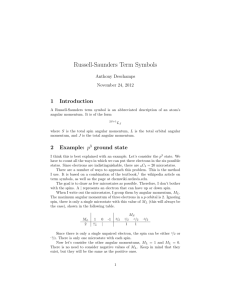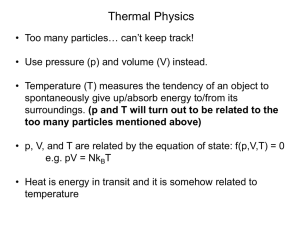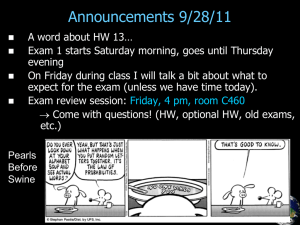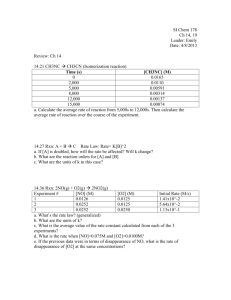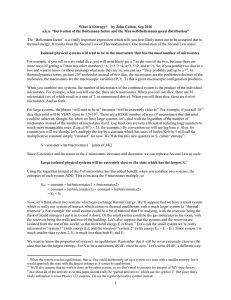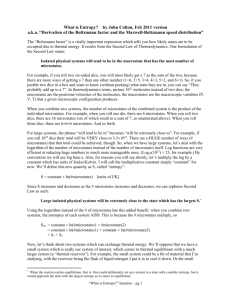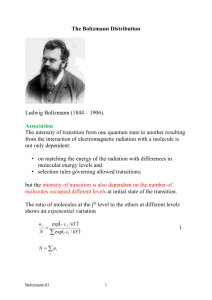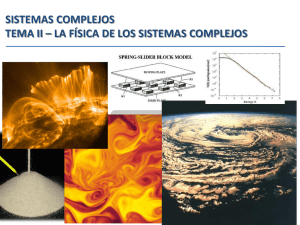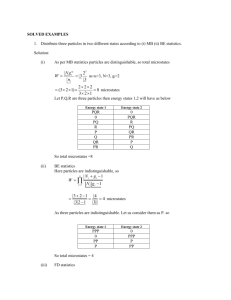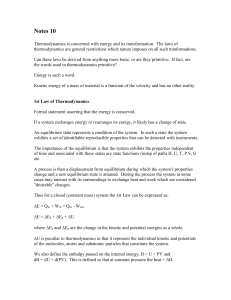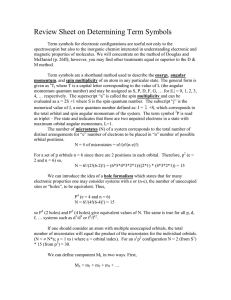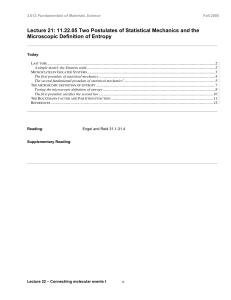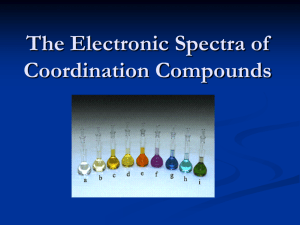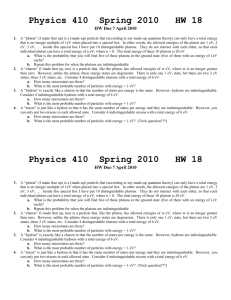Solutions to The smallest 2d Ising model
advertisement
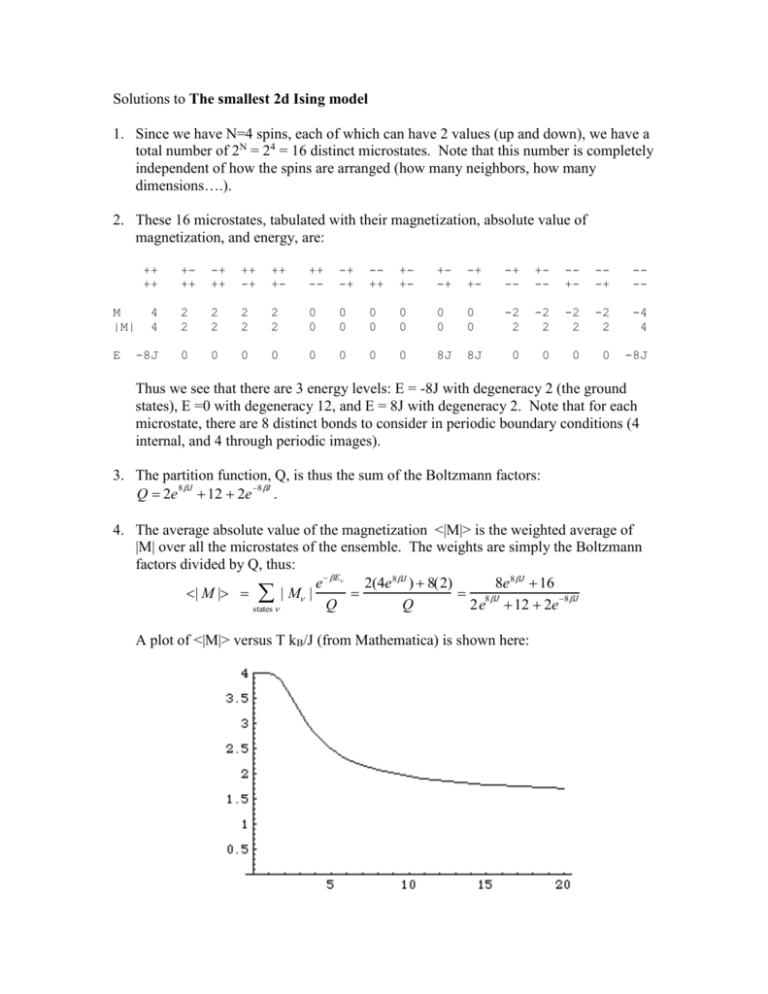
Solutions to The smallest 2d Ising model 1. Since we have N=4 spins, each of which can have 2 values (up and down), we have a total number of 2N = 24 = 16 distinct microstates. Note that this number is completely independent of how the spins are arranged (how many neighbors, how many dimensions….). 2. These 16 microstates, tabulated with their magnetization, absolute value of magnetization, and energy, are: ++ ++ M |M| E +++ -+ ++ ++ -+ ++ +- ++ -- -+ -+ -++ ++- +-+ -+ +- -+ -- +-- -+- --+ --- 4 4 2 2 2 2 2 2 2 2 0 0 0 0 0 0 0 0 0 0 0 0 -2 2 -2 2 -2 2 -2 2 -4 4 -8J 0 0 0 0 0 0 0 0 8J 8J 0 0 0 0 -8J Thus we see that there are 3 energy levels: E = -8J with degeneracy 2 (the ground states), E =0 with degeneracy 12, and E = 8J with degeneracy 2. Note that for each microstate, there are 8 distinct bonds to consider in periodic boundary conditions (4 internal, and 4 through periodic images). 3. The partition function, Q, is thus the sum of the Boltzmann factors: 8 J 8 J Q 2e 12 2e . 4. The average absolute value of the magnetization <|M|> is the weighted average of |M| over all the microstates of the ensemble. The weights are simply the Boltzmann factors divided by Q, thus: E e 2(4e 8 J ) 8(2) 8e 8 J 16 | M | | M | 8 J 8 J Q Q 2e 12 2e states A plot of <|M|> versus T kB/J (from Mathematica) is shown here: Contrast this with Figure 5.2 in the reading from Chandler’s Introduction to Modern Statistical Mechanics, showing <|M|> vs. T for an infinite Ising magnet. For the infinite case, <|M|> drops to zero sharply at a specific temperature, the critical temperature Tc. In contrast, for our 2x2 system, the decrease in <|M|> is smooth, even though there is a characteristic temperature range around T = 3-5 J/kB where most of the decrease in <|M|> occurs. Thus we don’t have a “sharp phase transition”, as this can only occur in the infinite system, where we have a divergence in the domain size at the critical point. Furthermore, at high temperatures, <|M|> -> 3/2, rather than zero as in the infinite system case, since as T -> infinity, all the Boltzmann factors approach one, and all the microstates are equally probable, and <|M|> is a uniform average over all 16 microstates, giving a non-zero value for <|M|>. At T=0, we find that <|M|>=4, consistent with the fact that at zero temperature, the system is found in the ground states with lowest energy, both of which have |M| = 4. 5. As can be seen from the table above, there are 5 values of M: -4, -2, 0, 2, 4. 6. For each value of M, we sum the Boltzmann factors for microstates having that value of M to get Q(M) (from which we get A(M) = -kBT lnQ(M) ). Thus, we find: ++ ++ M |M| E +++ -+ ++ ++ -+ ++ +- ++ -- -+ -+ -++ ++- +-+ -+ +- -+ -- +-- -+- --+ --- 4 4 2 2 2 2 2 2 2 2 0 0 0 0 0 0 0 0 0 0 0 0 -2 2 -2 2 -2 2 -2 2 -4 4 -8J 0 0 0 0 0 0 0 0 8J 8J 0 0 0 0 -8J Q(M)= exp(8J) A(M)= -8J 8J 4 -kBT ln 4 4 + 2 exp(-8J) -kBT ln[4 + 2 exp(-8J)] 4 exp(8J) -kBT ln 4 - Notice that for A(M=-4) = -8J = E(M=-4), since there is only one microstate with M=-4, and hence S(M=-4) = kB ln(1) = 0, i.e., A = E - T S = E here. For M = -2, A = -T S, since E = 0, and S = kB ln(4). For M = 0, we have 6 microstates, 2 of which have a higher energy than the other 4. Thus A here will be a complex function of T, since both energy and entropy contribute. (For M>0, the same reasoning as above applies.) 7. At T = 0, A(M) = -8J, 0, 0, 0, -8J. The lowest value of A occurs at M = -4 and M = 4. As T -> infinity, A(M) -> -8J, - kBT ln 4, - kBT ln 6, - kBT ln 4, -8J The lowest value of A occurs at M = 0 (in the limit of large T). In other words, at T = 0, energy dominates, and the lowest energy states have the lowest free energy. At high temperatures, entropy dominates, and the 6 microstates making up the M = 0 level dominate. This can be seen in the following graph plotting A(M) versus M: Here the red curve corresponds to T = 0, and the blue curve corresponds to T = 8 J/kB. As T increase beyond 8, the blue curve continues to drop. (For the figure, J=1.) 8. From the table of values for A(M) above, we see that A(M=0) is always less than A(M=-2) or A(M=2). Thus the minimum switches from M=-4 or M=4 at low temperatures to M=0 at high temperatures. This switch occurs at 8J kB T ln[4 2e 8 J ] 8 J ln[ 4 2e 8 J ] e 8 J 4 2e 8J then using y e 8 J y 4 2/y y 2 4y 2 0 y 2 6 J ln(2 6) / 8 8 J J 0.19 ln( 2 6) k B kB The critical temperature for the infinite Ising magnet is Tc = 2.269 J/kB. Thus, the finite 2x2 system favors zero magnetization at much lower temperatures than the infinite system. T 9. The energy of coupling to an external field is Efield = -MH. This is just linear in M, and adds to the energies above. Since A = E - TS, it also adds directly (linearly) to the free energy A as well. (This can also be verified by directly substituting the new energies into the equation for A(M) .) In particular, we find A(M)= -8J-4 -kBTln(4)-2 -kBTln[4+2exp(-8J)] -kBTln(4)+2 -8J+4 In this case, the curve for A(M) shifts slightly in the direction that the field favors, e.g. causing the minimum at M=4 to be lower than that at M=-4 (for <0). Nonetheless, at high enough T, the lowest minimum will occur at M=0.

